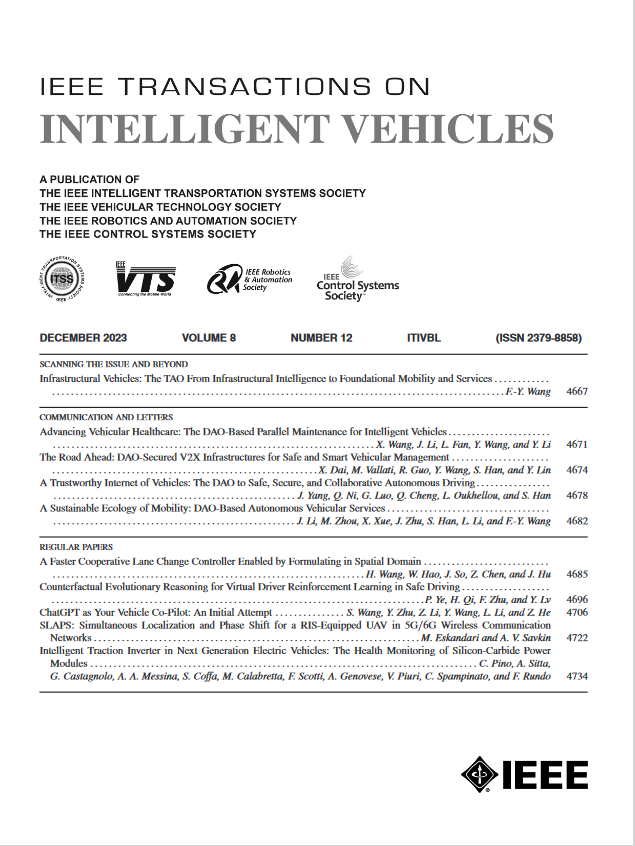利用经济高效的网络冗余增强汽车系统中传感器的容错能力
IF 14
1区 工程技术
Q1 COMPUTER SCIENCE, ARTIFICIAL INTELLIGENCE
引用次数: 0
摘要
在现代汽车中,有数以百计的传感器,其中许多传感器对安全至关重要,这意味着它们的运行故障可能会导致灾难性后果。这些传感器的传统容错方法是使用冗余传感器,这不可避免地增加了成本和开销。为了应对这一挑战,我们为冗余传感器提出了一个新的视角,我们称之为网络近似传感器。我们的想法是,与其完全依赖物理冗余,不如设计出有利于现有网络设施的传感器来创建冗余。此外,我们认识到冗余传感器并不需要与主传感器一样精确,因此我们利用了一种基于近似的模型,这种模型产生的开销较低。为此,我们的传感器在两个步骤中利用了车辆传感器之间的固有依赖关系:i) 识别相关依赖关系;ii) 设计回归模型。作为案例研究,我们将网络冗余方法应用于燃油控制系统,并使用硬件在环平台进行了故障注入实验,以分析容错性。与可靠性不同,性能指标可以考虑性能下降,因此我们采用性能指标来评估容错性。事实上,可靠性具有二元性,即系统要么正确要么失败。然而,车辆传感器在完美运行和完全失效之间会表现出不同程度的功能性。它们可能会出现部分性能下降,但这仍然是可以接受的。我们的实验表明,所提出的网络冗余方法不仅降低了高成本的物理开销(约 50%),还提高了可执行性(约 7%)。本文章由计算机程序翻译,如有差异,请以英文原文为准。
Enhancing Sensor Fault Tolerance in Automotive Systems With Cost-Effective Cyber Redundancy
In modern vehicles, there are hundreds of sensors, and many of them are safety-critical, which means a malfunction in their operation can cause catastrophic consequences. The conventional approach for the fault tolerance of these sensors is to use redundant sensors, which inevitably increases costs and overhead. To address this challenge, we propose a new perspective for redundant sensors, which we refer to as cyber-approximate sensors. The idea is that instead of relying solely on physical redundancy, we devise sensors favoring existing cyber facilities to create redundancy. Furthermore, recognizing that the redundant sensors do not need to be as accurate as the primary ones, we exploit an approximation-based model that incurs low overhead. To this end, our sensors employ inherent dependencies among vehicle sensors in two steps: i) identifying related dependencies and ii) designing a regression model. As a case study, we applied the cyber redundancy approach to a fuel control system and conducted fault injection experiments using the Hardware-in-the-Loop platform to analyze the fault tolerance. Since the performability metric, unlike reliability, can consider performance degradation, we employed the performability metric to evaluate fault tolerance. Indeed, reliability follows a binary nature, where a system is either correct or failed. However, vehicle sensors can exhibit varying degrees of functionality between perfect operation and complete failure. They might experience partial degradation, which can still be acceptable. Our experiments show that the proposed cyber redundancy approach not only reduces high-cost physical overhead (by roughly 50%) but also enhances performability (by approximately 7%).
求助全文
通过发布文献求助,成功后即可免费获取论文全文。
去求助
来源期刊

IEEE Transactions on Intelligent Vehicles
Mathematics-Control and Optimization
CiteScore
12.10
自引率
13.40%
发文量
177
期刊介绍:
The IEEE Transactions on Intelligent Vehicles (T-IV) is a premier platform for publishing peer-reviewed articles that present innovative research concepts, application results, significant theoretical findings, and application case studies in the field of intelligent vehicles. With a particular emphasis on automated vehicles within roadway environments, T-IV aims to raise awareness of pressing research and application challenges.
Our focus is on providing critical information to the intelligent vehicle community, serving as a dissemination vehicle for IEEE ITS Society members and others interested in learning about the state-of-the-art developments and progress in research and applications related to intelligent vehicles. Join us in advancing knowledge and innovation in this dynamic field.
 求助内容:
求助内容: 应助结果提醒方式:
应助结果提醒方式:


